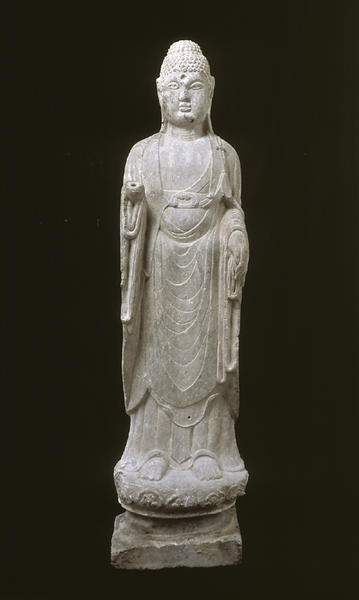如来立像
- 高平郡王洞伝来
- 唐時代
- 石灰石
- H-195
- 所蔵
- 龍門石窟研究所蔵
石灰石/高平郡王洞伝来 唐時代/総高195.0 cm 像高180.0 cm/
龍門石窟研究所蔵
龍門石窟東山の高平郡王洞に伝来し、関帝廟境内の洛陽古代芸術館に展示されていた。頂から台座まで一材から彫り出している。上げた右手先は欠失しているが、左手で衣の端をつまんで、蓮華座上に立っている。螺髪を表す頭部には地髪部と肉髻の段差があまりなく、額に大きな白毫を嵌入していた孔を有する。顔は下膨れ気味のズングリとしたもので、目鼻の彫りも明快さに欠けている。円筒形の首、体躯部の彫りにも精彩がなく、衣文も分厚く形式化している。このような作風は1976年河南省■[けい]陽[よう]県大海寺出土の弥勒菩薩像などの作風とも通ずることから、8世紀末から9世紀頃の制作と考えられる。
■は「火火」、わかんむりに水
Catalogue Entry
Limestone/ Said to be from the Gaopingjunwangdong Cave, Tang dynasty/
Overall H. 195.0 cm; Fig. H. 180.0 cm/ Longmen Caves Research Institute
This standing Buddha was originally in the Gaopingjunwangdong Cave on the Longmen East Hill and it has been displayed in the Luoyang Ancient Art Museum in Guanlin. The sculpture, from the top of the head to the bottom of the dais, was carved from a single block of limestone. The right arm is raised and the right hand is missing. The left hand grasps the end of the robe and the figure stands on a lotus pedestal. There is almost no differentiation between the usnisa and the head with both covered overall with spiral curl forms. The forehead has a large hole where the white curl mark would have been inlaid. The face is thickset with a slightly swelling jaw line and the drapery is also thickly carved and stylized. This style is similar to that found on the Maitreya bodhisattva image excavated at Dahaisi temple in Xingyang, Henan province and other images, and this image is thought to be from around the end of the 8th century through the 9th century.
Section 4; Works Excavated from the Fengxiansi Temple Site (see p. 78)The Fengxiansi temple site is located to the southwest of the south gate of the Longmen Caves, to the north of Weiwan village, and 300 meters from the Yi River. According to the inscription titled Heluo Shangdu Longmenshan zhi yang Dalushna xiangkangji carved in Kaiyuan 10 (722) during the reign of Emperor Xuanzhong, the Dafengxiansi temple was located to the south of the "great image" niche following an imperial decree made on the 15th day of the 8th month of Diaolu 1 (679).
From 1997 through 2000, this site was excavated and examined by a team made up members of the Luoyang City Bureau of Cultural Heritage and the Naples University, Italy. One temple building and the remains of waterworks were excavated during this study. In addition to building materials and tiles, limestone Buddhist images were also excavated from the temple site.
